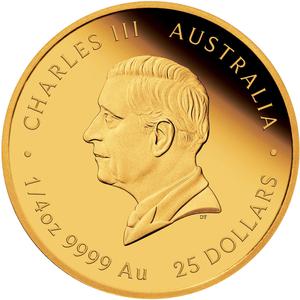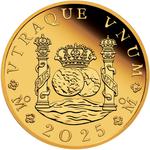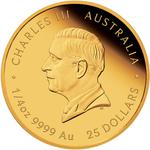
The reverse design of the coin re-creates the obverse of the famous Spanish dollar (also known as the "piece of eight"), which was widely used as the first international currency from the 16th to 19th centuries. It displays two hemispheres of a world map, crowned between the Pillars of Hercules; the two pillars are also crowned.
On ribbons wrapping the columns, the PLUS VLTRA motto. "Plus ultra" (spelled with V for the second U, as in old Latin) is a Latin phrase and the national motto of Spain. A reversal of the original phrase "non plus ultra" ("Nothing further beyond"), said to have been inscribed as a warning on the Pillars of Hercules at the Strait of Gibraltar (which marked the edge of the known world in antiquity), it has metaphorical suggestions of taking risks and striving for excellence. Its original version, the personal motto of the Holy Roman Emperor Charles V, also Duke of Burgundy and King of Spain (as Carlos I), was "Plus oultre" in French. The motto was adopted some decades after the discovery of the New World by Christopher Columbus.
It has been suggested that the S-shaped configuration of the banners around the columns explain the origin of the $ sign.
Around above, the inscription VTRAQUE VNUM, meaning "both are one" - a symbol of the unity of the Old World and the New World.
Around below, the year of issue 2025 (one troy ounce of 99.99% gold), surrounded by flowers and two Mo (small o above M) mint marks - for Mexico City, which is the mark of the Mexican Mint. This design element pays homage to the tradition of Spanish Empire coins bearing distinct mark signifying their minting location.
The face value and the precious metal content are on the obverse. |





 Buy this online from APMEX
Buy this online from APMEX
 Search for Australia: Gold Quarter Ounce 2025 Pillar Dollar on eBay
Search for Australia: Gold Quarter Ounce 2025 Pillar Dollar on eBay 
